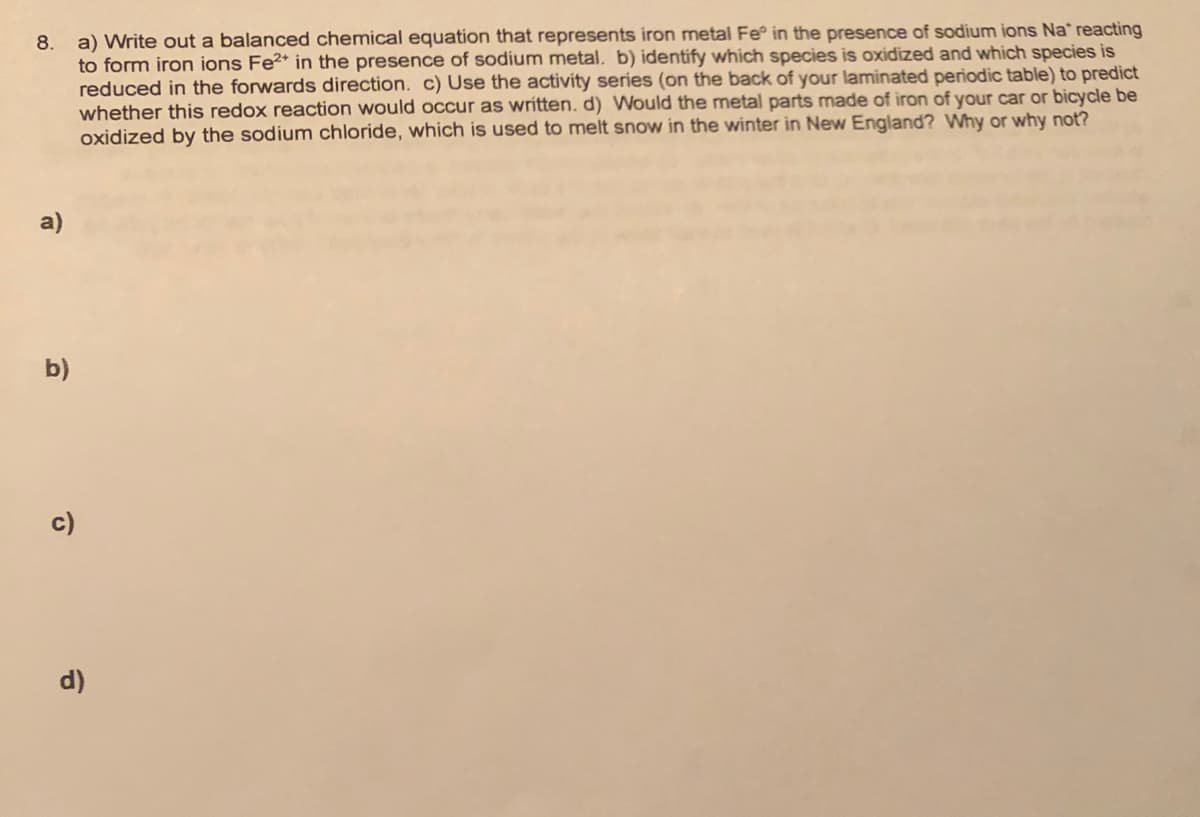8. a) Write out a balanced chemical equation that represents iron metal Fe in the presence of sodium ions Na reacting to form iron ions Fe2* in the presence of sodium metal. b) identify which species is oxidized and which species is reduced in the forwards direction. c) Use the activity series (on the back of your laminated periodic table) to predict whether this redox reaction would occur as written. d) Would the metal parts made of iron of your car or bicycle be oxidized by the sodium chloride, which is used to melt snow in the winter in New England? Why or why not?
8. a) Write out a balanced chemical equation that represents iron metal Fe in the presence of sodium ions Na reacting to form iron ions Fe2* in the presence of sodium metal. b) identify which species is oxidized and which species is reduced in the forwards direction. c) Use the activity series (on the back of your laminated periodic table) to predict whether this redox reaction would occur as written. d) Would the metal parts made of iron of your car or bicycle be oxidized by the sodium chloride, which is used to melt snow in the winter in New England? Why or why not?
Chemistry: The Molecular Science
5th Edition
ISBN:9781285199047
Author:John W. Moore, Conrad L. Stanitski
Publisher:John W. Moore, Conrad L. Stanitski
Chapter19: The Chemistry Of The Main-group Elements
Section: Chapter Questions
Problem 45QRT
Related questions
Question
100%

Transcribed Image Text:a) Write out a balanced chemical equation that represents iron metal Fe° in the presence of sodium ions Na* reacting
to form iron ions Fe2* in the presence of sodium metal. b) identify which species is oxidized and which species is
reduced in the forwards direction. c) Use the activity series (on the back of your laminated periodic table) to predict
whether this redox reaction would occur as written. d) Would the metal parts made of iron of your car or bicycle be
oxidized by the sodium chloride, which is used to melt snow in the winter in New England? Why or why not?
8.
a)
b)
c)
d)
Expert Solution
This question has been solved!
Explore an expertly crafted, step-by-step solution for a thorough understanding of key concepts.
Step by step
Solved in 2 steps with 1 images

Knowledge Booster
Learn more about
Need a deep-dive on the concept behind this application? Look no further. Learn more about this topic, chemistry and related others by exploring similar questions and additional content below.Recommended textbooks for you

Chemistry: The Molecular Science
Chemistry
ISBN:
9781285199047
Author:
John W. Moore, Conrad L. Stanitski
Publisher:
Cengage Learning

Introductory Chemistry: A Foundation
Chemistry
ISBN:
9781337399425
Author:
Steven S. Zumdahl, Donald J. DeCoste
Publisher:
Cengage Learning

Chemistry: Matter and Change
Chemistry
ISBN:
9780078746376
Author:
Dinah Zike, Laurel Dingrando, Nicholas Hainen, Cheryl Wistrom
Publisher:
Glencoe/McGraw-Hill School Pub Co

Chemistry: The Molecular Science
Chemistry
ISBN:
9781285199047
Author:
John W. Moore, Conrad L. Stanitski
Publisher:
Cengage Learning

Introductory Chemistry: A Foundation
Chemistry
ISBN:
9781337399425
Author:
Steven S. Zumdahl, Donald J. DeCoste
Publisher:
Cengage Learning

Chemistry: Matter and Change
Chemistry
ISBN:
9780078746376
Author:
Dinah Zike, Laurel Dingrando, Nicholas Hainen, Cheryl Wistrom
Publisher:
Glencoe/McGraw-Hill School Pub Co

General Chemistry - Standalone book (MindTap Cour…
Chemistry
ISBN:
9781305580343
Author:
Steven D. Gammon, Ebbing, Darrell Ebbing, Steven D., Darrell; Gammon, Darrell Ebbing; Steven D. Gammon, Darrell D.; Gammon, Ebbing; Steven D. Gammon; Darrell
Publisher:
Cengage Learning

Chemistry for Today: General, Organic, and Bioche…
Chemistry
ISBN:
9781305960060
Author:
Spencer L. Seager, Michael R. Slabaugh, Maren S. Hansen
Publisher:
Cengage Learning
